 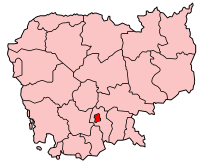 Phnom Penh official Romanization: Phnum Pénh; pronounced is
the largest, most populous and capital city of Cambodia. It is also the
capital of the Phnom Penh municipality. Once known as the "Pearl of
Asia" in the 1920s, Phnom Penh, along with Siem Reap, is a significant
global and domestic tourist destination for Cambodia. Phnom Penh is
known for its traditional Khmer and French influenced architecture.
Phnom Penh is the wealthiest and most populous city in Cambodia. It is
also the commercial, political and cultural hub of Cambodia and is home
to more than one million of Cambodia's population of over 13 million.
Phnom Penh official Romanization: Phnum Pénh; pronounced is
the largest, most populous and capital city of Cambodia. It is also the
capital of the Phnom Penh municipality. Once known as the "Pearl of
Asia" in the 1920s, Phnom Penh, along with Siem Reap, is a significant
global and domestic tourist destination for Cambodia. Phnom Penh is
known for its traditional Khmer and French influenced architecture.
Phnom Penh is the wealthiest and most populous city in Cambodia. It is
also the commercial, political and cultural hub of Cambodia and is home
to more than one million of Cambodia's population of over 13 million.
Etymology
The city takes its name from the Wat Phnom Daun Penh (known now as just the Wat Phnom or Hill Temple), built in 1373 to house five statues of Buddha on a man made hill 27 metres (89 ft) high. It was named after Daun Penh (Grandma Penh), a wealthy widow.
Phnom Penh was also previously known as Krong Chaktomuk meaning "City of Four Faces". This name refers to the junction where the Mekong, Bassac, and Tonle Sap rivers cross to form an "X" where the capital is situated. Krong Chaktomuk is an abbreviation of its ceremonial name given by King Ponhea Yat which was "Krong Chaktomuk Mongkol Sakal Kampuchea Thipadei Sereythor Inthabot Borei Roth Reach Seima Maha Nokor".
History
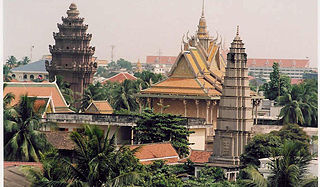 Phnom Penh first became the capital of Cambodia after Ponhea Yat, king of the Khmer Empire, moved the capital from Angkor Thom after it was captured by Siam a few years earlier. There are stupa behind Wat Phnom that house the remains of Ponhea Yat and the royal family as well as the remaining Buddhist statues from the Angkorean era. There is a legend that tells how Phnom Penh was created.
It was not until 1866, under the reign of King Norodom I, that Phnom Penh became the permanent seat of government, and the Royal Palace (pictured) was built. This marked the beginning of the transformation of what was essentially a village into a great city with the French Colonialists expanding the canal system to control the wetlands, constructing roads and building a port.
By the 1920s, Phnom Penh was known as the Pearl of Asia, and over the next four decades continued to experience growth with the building of a railway to Sihanoukville and the Pochentong International Airport.
The exterior of the Tuol Sleng Genocide Museum, Phnom Penh
During the Vietnam War, Cambodia was used as a base by the North Vietnamese Army and the Viet Cong, and thousands of refugees from across the country flooded the city to escape the fighting between their own government troops, the NVA/NLF, the South Vietnamese and its allies and the Khmer Rouge. By 1975, the population was 2,000,000, the bulk of them refugees from the fighting. The city fell to the Khmer Rouge on April 17. Many of its residents, those who were wealthy and educated, were forced to do labor on rural farms as "new people". Tuol Svay Prey High School was taken over by Pol Pot's forces and was turned into the S-21 prison camp, where Cambodians were detained and tortured. Pol Pot desired a return to an agrarian economy and therefore killed anyone who was educated, who wore glasses, or who did not have calloused hands to cleanse the population of the taint of westernization. Many others starved to death as a result of failure of the agrarian society and the sale of Cambodia's rice to China in exchange for bullets and weaponry. Tuol Svay Prey High School is now the Tuol Sleng Museum in which Khmer Rouge torture devices and photos of their victims are displayed. Choeung Ek (The Killing Fields), 15 kilometres (9 mi) away, where the Khmer Rouge marched prisoners from Tuol Sleng to be murdered and buried in shallow pits, is also now a memorial to those who were killed by the regime.
The Khmer Rouge were driven out of Phnom Penh by the Vietnamese in 1979 and people began to return to the city. Vietnam is historically a state with which Cambodia has had many conflicts, therefore this liberation was and is viewed with mixed emotions by the Cambodians. A period of reconstruction began, spurred by continuing stability of government, attracting new foreign investment and aid by countries including France, Australia, and Japan. Loans were made from the Asian Development Bank and the World Bank to reinstate a clean water supply, roads and other infrastructure. The 1998 Census put Phnom Penh's population at 862,000;[3] by 2001 it was estimated at slightly over 1 million.
Phnom Penh first became the capital of Cambodia after Ponhea Yat, king of the Khmer Empire, moved the capital from Angkor Thom after it was captured by Siam a few years earlier. There are stupa behind Wat Phnom that house the remains of Ponhea Yat and the royal family as well as the remaining Buddhist statues from the Angkorean era. There is a legend that tells how Phnom Penh was created.
It was not until 1866, under the reign of King Norodom I, that Phnom Penh became the permanent seat of government, and the Royal Palace (pictured) was built. This marked the beginning of the transformation of what was essentially a village into a great city with the French Colonialists expanding the canal system to control the wetlands, constructing roads and building a port.
By the 1920s, Phnom Penh was known as the Pearl of Asia, and over the next four decades continued to experience growth with the building of a railway to Sihanoukville and the Pochentong International Airport.
The exterior of the Tuol Sleng Genocide Museum, Phnom Penh
During the Vietnam War, Cambodia was used as a base by the North Vietnamese Army and the Viet Cong, and thousands of refugees from across the country flooded the city to escape the fighting between their own government troops, the NVA/NLF, the South Vietnamese and its allies and the Khmer Rouge. By 1975, the population was 2,000,000, the bulk of them refugees from the fighting. The city fell to the Khmer Rouge on April 17. Many of its residents, those who were wealthy and educated, were forced to do labor on rural farms as "new people". Tuol Svay Prey High School was taken over by Pol Pot's forces and was turned into the S-21 prison camp, where Cambodians were detained and tortured. Pol Pot desired a return to an agrarian economy and therefore killed anyone who was educated, who wore glasses, or who did not have calloused hands to cleanse the population of the taint of westernization. Many others starved to death as a result of failure of the agrarian society and the sale of Cambodia's rice to China in exchange for bullets and weaponry. Tuol Svay Prey High School is now the Tuol Sleng Museum in which Khmer Rouge torture devices and photos of their victims are displayed. Choeung Ek (The Killing Fields), 15 kilometres (9 mi) away, where the Khmer Rouge marched prisoners from Tuol Sleng to be murdered and buried in shallow pits, is also now a memorial to those who were killed by the regime.
The Khmer Rouge were driven out of Phnom Penh by the Vietnamese in 1979 and people began to return to the city. Vietnam is historically a state with which Cambodia has had many conflicts, therefore this liberation was and is viewed with mixed emotions by the Cambodians. A period of reconstruction began, spurred by continuing stability of government, attracting new foreign investment and aid by countries including France, Australia, and Japan. Loans were made from the Asian Development Bank and the World Bank to reinstate a clean water supply, roads and other infrastructure. The 1998 Census put Phnom Penh's population at 862,000;[3] by 2001 it was estimated at slightly over 1 million.
Geography
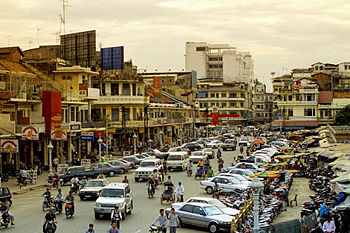 A Buddhist monk walking in front of the Royal palace in Phnom Penh.
Phnom Penh is located in the south-central region of Cambodia, at the confluence of the Tonlé Sap, Mekong, and Bassac rivers. These rivers provide potential freshwater and other resources. The city, located at 11.55° N 104.91667° E (11°33' North, 104°55' East, [1]). Covers an area of 375 square kilometres (145 sq mi) which some 11,401 hectares (28,172 acres) in the municipality and 26,106 hectares (64,509 acres) of roads. The agricultural land in the municipality amounts to 34.685 square kilometres (13 sq mi) with some 1.476 square kilometres (365 acres) under irrigation.
The climate is hot year-round with only minor variations. City temperatures range from 10° to 38 °C (50° to 100 °F) and experiences tropical monsoons. Southwest monsoons blow inland bringing moisture-laden winds from the Gulf of Thailand and Indian Ocean from May to October. The northeast monsoon ushers in the dry season, which lasts from November to March. The city experiences the heaviest precipitation from September to October with the driest period occurring from January to February.
It has two distinct seasons. The rainy season, which runs from May to October, can see temperatures raise up to 40 °C (104 °F) around April and is generally accompanied with high humidity. The dry season lasts from November to April when temperatures can drop to 22 °C (72 °F). The best months to visit the city are November to January when temperatures and humidity are lower.
A Buddhist monk walking in front of the Royal palace in Phnom Penh.
Phnom Penh is located in the south-central region of Cambodia, at the confluence of the Tonlé Sap, Mekong, and Bassac rivers. These rivers provide potential freshwater and other resources. The city, located at 11.55° N 104.91667° E (11°33' North, 104°55' East, [1]). Covers an area of 375 square kilometres (145 sq mi) which some 11,401 hectares (28,172 acres) in the municipality and 26,106 hectares (64,509 acres) of roads. The agricultural land in the municipality amounts to 34.685 square kilometres (13 sq mi) with some 1.476 square kilometres (365 acres) under irrigation.
The climate is hot year-round with only minor variations. City temperatures range from 10° to 38 °C (50° to 100 °F) and experiences tropical monsoons. Southwest monsoons blow inland bringing moisture-laden winds from the Gulf of Thailand and Indian Ocean from May to October. The northeast monsoon ushers in the dry season, which lasts from November to March. The city experiences the heaviest precipitation from September to October with the driest period occurring from January to February.
It has two distinct seasons. The rainy season, which runs from May to October, can see temperatures raise up to 40 °C (104 °F) around April and is generally accompanied with high humidity. The dry season lasts from November to April when temperatures can drop to 22 °C (72 °F). The best months to visit the city are November to January when temperatures and humidity are lower.
|
Weather averages for Phnom Penh |
|
Month |
Jan |
Feb |
Mar |
Apr |
May |
Jun |
Jul |
Aug |
Sep |
Oct |
Nov |
Dec |
| Average
high °C (°F) |
31 (88) |
33 (91) |
34 (93) |
35 (95) |
34 (93) |
33 (91) |
32 (90) |
32 (90) |
31 (88) |
31 (87) |
30 (86) |
30 (86) |
| Average
low °C (°F) |
22 (71) |
22 (72) |
23 (74) |
24 (76) |
24 (76) |
24 (76) |
24 (76) |
24 (76) |
24 (76) |
24 (76) |
23 (74) |
22 (71) |
|
Precipitation mm (inch) |
7.6
(0.30) |
10.2
(0.40) |
35.6
(1.40) |
78.7
(3.10) |
144.8
(5.70) |
147.3
(5.80) |
152.4
(6.00) |
154.9
(6.10) |
226.1
(8.90) |
251.5
(9.90) |
139.7
(5.50) |
43.2
(1.70) |
Economy
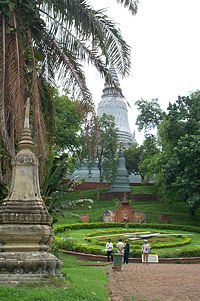 Situated at the confluence of the Mekong , Bassac and Tonlé Sap Rivers, Cambodia's capital, Phnom Penh, has a population of approximately two million people. Despite some dilapidation resulting from decades of war, the city retains its traditional Khmer and colonial charm. French villas along tree-lined boulevards remind the visitor that the city was once considered a gem of Southeast Asia. Double-digit economic growth rates in recent years have triggered an economic boom, with new hotels, restaurants, bars, and residential buildings springing up around the city. Phnom Penh's wealth of historical and cultural sites makes it a very popular tourist destination.
The main tourist attractions in Phnom Penh include the Royal Palace, Phsar Thom Thmei, the Silver Pagoda, the National Museum, Independence Monument (Khmer: Vimean Akareach), the Tuol Sleng Genocide Museum, and Wat Phnom. On the outskirt of the city is the Choeung Ek Genocide Center.
The Royal Palace of Phnom Penh are a complex of buildings which are the royal abode of the Kingdom of Cambodia. Its full name in the Khmer language is Preah Barom Reachea Vaeng Chaktomuk. The Kings of Cambodia have occupied it since it was built in 1866, with a period of absence when the country came into turmoil during and after the reign of the Khmer Rouge.
The palace was started after King Norodom relocated the royal capital from Oudong to Phnom Penh after the mid-1800s. It was gradually built atop an old citadel called Banteay Kev. It faces towards the East and is situated at the Western bank of four divisions at the Mekong River called Chaktomuk (an allusion to Brahma).
Wat Phnom is a historical and one of the most important pagoda located in Phnom Penh. Built in 1373,it stands at 27 metres (89 ft) and is by far the tallest religious structure in the city. Built on an artificial hill by the wealthy widow Daun Chi Penh after a great flood washed statues of Buddha downstream, it has since been renovated. There have been many additions to the original shrines over the centuries. The largest stupa houses the ashes of King Ponhea Yat and it is the center of city celebrations for the Cambodian New Year, and Pchum Benh festivals.
The National Museum, Phnom Penh is Cambodia's largest and was built in 1917–20 by the French colonial authorities then in control of Cambodia, in a traditional Khmer style, with French influence.
The Tuol Sleng Genocide Museum, a former high school which was used as the notorious Security Prison 21 (S-21) concentration camp by the Khmer Rouge regime from its rise to power in 1975 to its fall in 1979 is one of the city's most moving landmarks.
From 1975 to 1979, an estimated 17,000 people were imprisoned at Tuol Sleng (some estimates suggest a number as high as 20,000). The prisoners were selected from all around the country, and usually were former Khmer Rouge members and soldiers, accused of treason. Classrooms were converted into tiny prison and torture chambers and all the windows were covered with iron bars and barbed wire to prevent prisoner escapes.
In 1979, the prison was uncovered by the invading Vietnamese army. In 1980, the prison was reopened as a historical museum memorializing the actions of the Khmer Rouge regime. The museum is open to the public, and receives an average of 500 visitors every day.
The Cambodia-Vietnam Friendship Monument is a large concrete monument to the former alliance between Vietnam and Cambodia located in the centre of Phnom Penh not far from the Royal Palace. It was built in the late 1970s by the communist regime which took power after the Vietnamese invasion of Cambodia, which overthrew the Khmer Rouge regime.
Situated at the confluence of the Mekong , Bassac and Tonlé Sap Rivers, Cambodia's capital, Phnom Penh, has a population of approximately two million people. Despite some dilapidation resulting from decades of war, the city retains its traditional Khmer and colonial charm. French villas along tree-lined boulevards remind the visitor that the city was once considered a gem of Southeast Asia. Double-digit economic growth rates in recent years have triggered an economic boom, with new hotels, restaurants, bars, and residential buildings springing up around the city. Phnom Penh's wealth of historical and cultural sites makes it a very popular tourist destination.
The main tourist attractions in Phnom Penh include the Royal Palace, Phsar Thom Thmei, the Silver Pagoda, the National Museum, Independence Monument (Khmer: Vimean Akareach), the Tuol Sleng Genocide Museum, and Wat Phnom. On the outskirt of the city is the Choeung Ek Genocide Center.
The Royal Palace of Phnom Penh are a complex of buildings which are the royal abode of the Kingdom of Cambodia. Its full name in the Khmer language is Preah Barom Reachea Vaeng Chaktomuk. The Kings of Cambodia have occupied it since it was built in 1866, with a period of absence when the country came into turmoil during and after the reign of the Khmer Rouge.
The palace was started after King Norodom relocated the royal capital from Oudong to Phnom Penh after the mid-1800s. It was gradually built atop an old citadel called Banteay Kev. It faces towards the East and is situated at the Western bank of four divisions at the Mekong River called Chaktomuk (an allusion to Brahma).
Wat Phnom is a historical and one of the most important pagoda located in Phnom Penh. Built in 1373,it stands at 27 metres (89 ft) and is by far the tallest religious structure in the city. Built on an artificial hill by the wealthy widow Daun Chi Penh after a great flood washed statues of Buddha downstream, it has since been renovated. There have been many additions to the original shrines over the centuries. The largest stupa houses the ashes of King Ponhea Yat and it is the center of city celebrations for the Cambodian New Year, and Pchum Benh festivals.
The National Museum, Phnom Penh is Cambodia's largest and was built in 1917–20 by the French colonial authorities then in control of Cambodia, in a traditional Khmer style, with French influence.
The Tuol Sleng Genocide Museum, a former high school which was used as the notorious Security Prison 21 (S-21) concentration camp by the Khmer Rouge regime from its rise to power in 1975 to its fall in 1979 is one of the city's most moving landmarks.
From 1975 to 1979, an estimated 17,000 people were imprisoned at Tuol Sleng (some estimates suggest a number as high as 20,000). The prisoners were selected from all around the country, and usually were former Khmer Rouge members and soldiers, accused of treason. Classrooms were converted into tiny prison and torture chambers and all the windows were covered with iron bars and barbed wire to prevent prisoner escapes.
In 1979, the prison was uncovered by the invading Vietnamese army. In 1980, the prison was reopened as a historical museum memorializing the actions of the Khmer Rouge regime. The museum is open to the public, and receives an average of 500 visitors every day.
The Cambodia-Vietnam Friendship Monument is a large concrete monument to the former alliance between Vietnam and Cambodia located in the centre of Phnom Penh not far from the Royal Palace. It was built in the late 1970s by the communist regime which took power after the Vietnamese invasion of Cambodia, which overthrew the Khmer Rouge regime.
Shopping
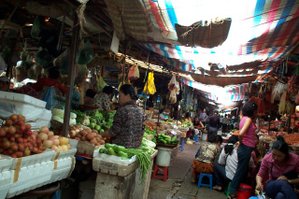 The market was built in an intensely art deco style by the French when Cambodia was under colonial rule.
Phsar Thom Thmei market was built in the shape of a dome in 1937 and is the capital's main shopping centre.
Nowadays, the market is a tourist hot spot, most tourists that came to Phnom Penh visited this market because they want to see the varieties of products that this market has to offer. The four wings of the yellow coloured Phsar Thom Thmei are teeming with numerous stalls selling gold and silver jewellery, antique coins, clothing, clocks, flowers, food, fabrics and shoes.
The Chan Chhaya Pavilion of the Royal Palace, as seen from Sothearos Blvd.
The market was built in an intensely art deco style by the French when Cambodia was under colonial rule.
Phsar Thom Thmei market was built in the shape of a dome in 1937 and is the capital's main shopping centre.
Nowadays, the market is a tourist hot spot, most tourists that came to Phnom Penh visited this market because they want to see the varieties of products that this market has to offer. The four wings of the yellow coloured Phsar Thom Thmei are teeming with numerous stalls selling gold and silver jewellery, antique coins, clothing, clocks, flowers, food, fabrics and shoes.
The Chan Chhaya Pavilion of the Royal Palace, as seen from Sothearos Blvd.
Newspapers
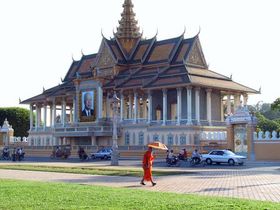 The Phnom Penh Post is a fortnightly English-language newspaper published in Phnom Penh. Founded in 1992 by publisher Michael Hayes, it is Cambodia's oldest English-language newspaper. It is printed in full-color Berliner format.
It has a staff of Cambodian and foreign journalists covering national news, and also prints a police blotter, which has items translated from local Khmer-language dailies.
Since its founding in Phnom Penh in July 1992, the printed edition has been published on a fortnightly basis, and read in Cambodia and worldwide by over 20,000 people in more than 40 countries.
The Cambodia Daily is Cambodia's only English-language daily newspaper based in Phnom Penh. It was started in 1993 by Bernard Krisher, an American journalist. Krisher hired two young and relatively inexperienced journalists, Barton Biggs and Robin McDowell, as the paper's first editors. The first issue was published in 1993, and the paper has published ever since. It is printed in an A4-size format and is delivered six days a week, Monday to Saturday, with the Saturday edition a full-color Weekend magazine. The Monday to Friday editions are black and white. The Daily has access to many major wire services (Associated Press, The New York Times, The Washington Post) and has a staff of Cambodian and foreign journalists covering local and national news. A daily section in Khmer language carries articles translated from the main English-language section. An international edition is available by annual subscription for US$200; each weekly edition compiles the staff-produced content from the previous week.
The Phnom Penh Post is a fortnightly English-language newspaper published in Phnom Penh. Founded in 1992 by publisher Michael Hayes, it is Cambodia's oldest English-language newspaper. It is printed in full-color Berliner format.
It has a staff of Cambodian and foreign journalists covering national news, and also prints a police blotter, which has items translated from local Khmer-language dailies.
Since its founding in Phnom Penh in July 1992, the printed edition has been published on a fortnightly basis, and read in Cambodia and worldwide by over 20,000 people in more than 40 countries.
The Cambodia Daily is Cambodia's only English-language daily newspaper based in Phnom Penh. It was started in 1993 by Bernard Krisher, an American journalist. Krisher hired two young and relatively inexperienced journalists, Barton Biggs and Robin McDowell, as the paper's first editors. The first issue was published in 1993, and the paper has published ever since. It is printed in an A4-size format and is delivered six days a week, Monday to Saturday, with the Saturday edition a full-color Weekend magazine. The Monday to Friday editions are black and white. The Daily has access to many major wire services (Associated Press, The New York Times, The Washington Post) and has a staff of Cambodian and foreign journalists covering local and national news. A daily section in Khmer language carries articles translated from the main English-language section. An international edition is available by annual subscription for US$200; each weekly edition compiles the staff-produced content from the previous week.
Education
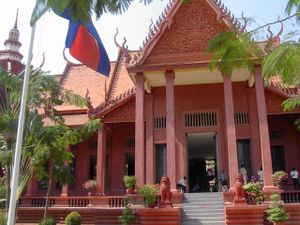 The Royal University of Phnom Penh (RUPP) is the oldest and largest institution of higher education in Cambodia. As of 2007, the university has over 5,000 students across three campuses, and offers a wide range of high-quality courses within the Faculty of Science, the Faculty of Social Sciences and Humanities, and the Institute of Foreign Languages (IFL).
The University has approximately 200 teaching staff, seven of whom have PhDs, 66 who have master degrees and the remainder with undergraduate qualifications. There are over 176 administrative and support staff. Various international and non-government organizations also provide adjunct faculty members.
The Royal University of Phnom Penh began as the Royal Khmer University in 1960. It opened during a period of intense growth in Cambodia and expanded rapidly to include a National Institute of Judicial and Economic Studies, a Royal School of Medicine, a National School of Commerce, a National Pedagogical Institute, a Faculty of Letters and Human Sciences, and a Faculty of Science and Technology. The language of instruction during this period was French.
French colonial buildings in Phnom Penh
With the establishment of the Khmer Republic in 1970, the Royal Khmer University became the Phnom Penh University. Between 1965 and 1975 there were nine faculties, namely the Ecole Normale Supérieure (Higher Normal College), Letters and Humanities, Science, Pharmacy, Law and Economics, Medicine and Dentistry, Commerce, Pedagogy, and the Languages Institute.
However the Khmer Rouge period of saw the closure and destruction of schools, the decimation of the teaching service and the cessation of formal education and the college was closed.
In 1980, the Ecole Normale Supérieure (Higher Normal College) reopened, again teaching predominantly in French. In 1981, the Institute of Foreign Languages (IFL) began, initially training students to become Vietnamese and Russian teachers. The purpose of both colleges was to provide surviving graduates of primary school or above with crash courses in teaching.
In 1988, the college and the IFL merged to create Phnom Penh University, and in 1996 the name was changed to the Royal University of Phnom Penh.
During the past decade, the University has grown and now includes the Faculty of Science, Faculty of Social Sciences and Humanities, and the Institute of Foreign Languages. In 2001, the University began its first postgraduate degrees with the Graduate Diploma and Master's Courses in Tourism Development.
The Royal University of Phnom Penh (RUPP) is the oldest and largest institution of higher education in Cambodia. As of 2007, the university has over 5,000 students across three campuses, and offers a wide range of high-quality courses within the Faculty of Science, the Faculty of Social Sciences and Humanities, and the Institute of Foreign Languages (IFL).
The University has approximately 200 teaching staff, seven of whom have PhDs, 66 who have master degrees and the remainder with undergraduate qualifications. There are over 176 administrative and support staff. Various international and non-government organizations also provide adjunct faculty members.
The Royal University of Phnom Penh began as the Royal Khmer University in 1960. It opened during a period of intense growth in Cambodia and expanded rapidly to include a National Institute of Judicial and Economic Studies, a Royal School of Medicine, a National School of Commerce, a National Pedagogical Institute, a Faculty of Letters and Human Sciences, and a Faculty of Science and Technology. The language of instruction during this period was French.
French colonial buildings in Phnom Penh
With the establishment of the Khmer Republic in 1970, the Royal Khmer University became the Phnom Penh University. Between 1965 and 1975 there were nine faculties, namely the Ecole Normale Supérieure (Higher Normal College), Letters and Humanities, Science, Pharmacy, Law and Economics, Medicine and Dentistry, Commerce, Pedagogy, and the Languages Institute.
However the Khmer Rouge period of saw the closure and destruction of schools, the decimation of the teaching service and the cessation of formal education and the college was closed.
In 1980, the Ecole Normale Supérieure (Higher Normal College) reopened, again teaching predominantly in French. In 1981, the Institute of Foreign Languages (IFL) began, initially training students to become Vietnamese and Russian teachers. The purpose of both colleges was to provide surviving graduates of primary school or above with crash courses in teaching.
In 1988, the college and the IFL merged to create Phnom Penh University, and in 1996 the name was changed to the Royal University of Phnom Penh.
During the past decade, the University has grown and now includes the Faculty of Science, Faculty of Social Sciences and Humanities, and the Institute of Foreign Languages. In 2001, the University began its first postgraduate degrees with the Graduate Diploma and Master's Courses in Tourism Development.
Sport
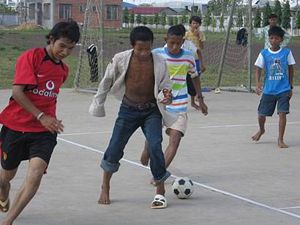 Cambodia has increasingly become involved in sports over the last 30 years.
Football and the martial arts as in the rest of the country are popular in particular. The martial arts of Bokator, Pradal Serey (Khmer kick boxing) and Khmer traditional wrestling have venues in Phnom Penh watched by dedicated spectators.
The most prominent of venues in the city is the Phnom Pehn National Olympic Stadium with a capacity of 50,000. Built in 1964 it is home to the Cambodian national football team. Noted clubs include Hello United, Khemara and Military Police.
Cambodia has increasingly become involved in sports over the last 30 years.
Football and the martial arts as in the rest of the country are popular in particular. The martial arts of Bokator, Pradal Serey (Khmer kick boxing) and Khmer traditional wrestling have venues in Phnom Penh watched by dedicated spectators.
The most prominent of venues in the city is the Phnom Pehn National Olympic Stadium with a capacity of 50,000. Built in 1964 it is home to the Cambodian national football team. Noted clubs include Hello United, Khemara and Military Police.
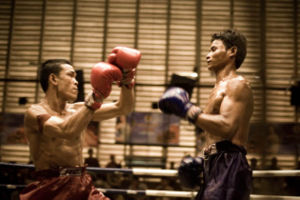

|

